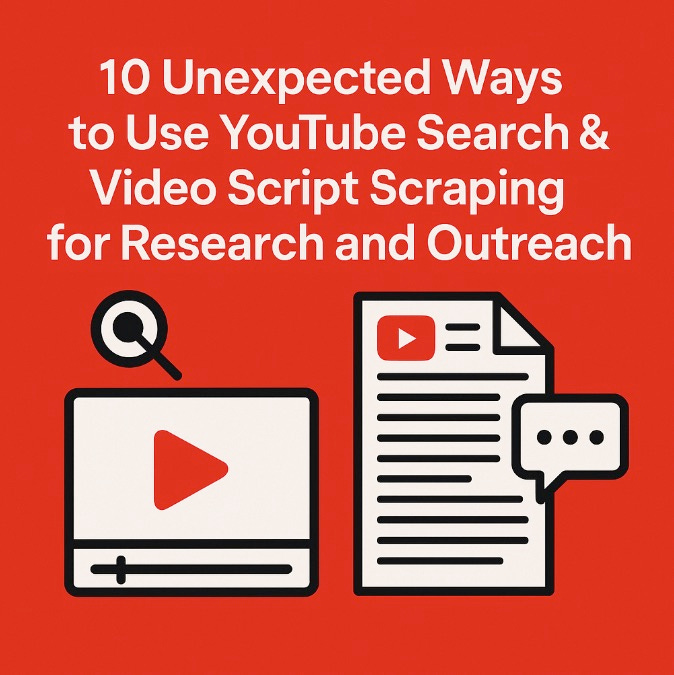10 Unexpected Ways to Use YouTube Search & Video Script Scraping for Research and Outreach
Most people go to YouTube to watch — but if you're paying attention, YouTube is also one of the most powerful databases for research, lead generation, and audience intelligence.
By scraping YouTube search results and video transcripts (scripts), you can unlock insights your competitors overlook — and turn videos into data-rich goldmines for outreach, product development, and marketing.
1. Find Influencers Before They Blow Up
Scrape YouTube search results for niche topics and sort by “Newest.” You’ll discover small creators with real engagement who are open to partnerships — before their rates skyrocket.
2. Identify Product Pain Points from Real Conversations
Scrape video scripts from product reviews or unboxings to extract complaints, issues, and wish lists straight from the mouths of real users.
3. Build Lead Lists from Niche Channels
Use YouTube search scraping to find all the top videos for “[industry] software tutorial” or “[problem] solution” and extract creators' emails and social links for personalized outreach.
4. Discover Untapped Content Gaps
Scrape video titles and descriptions to spot what’s not being said in your niche. If everyone’s covering “How to Set Up,” but no one’s talking about “Common Mistakes,” you’ve got a content opportunity.
5. Extract Global Insights from Multilingual Video Scripts
Scrape video transcripts in other languages — not just English — to tap into a global stream of user-generated knowledge. With automated translation, you can uncover product feedback, cultural trends, and unique use cases that never make it into mainstream English content. It’s like getting customer research from markets your competitors aren’t even watching.
6. Track Shifts in Industry Language
By scraping video transcripts over time, you can track how people talk about topics (e.g., from “AI tools” to “AI agents”). This is gold for copywriting, branding, or keyword strategy.
7. Extract Actionable Quotes for Content or Ads
Pull memorable lines from scripts or comments to repurpose into marketing copy, blog intros, or even paid ad hooks that sound authentic and human.
8. Research Trends in Real Time
Scrape “Today’s trending” or filter by date + topic (e.g., “Midjourney alternatives April 2025”) to get early signals of emerging tools, formats, or talking points.
9. Automate Competitor Monitoring
Scrape new uploads and scripts from competitor channels to see what features, updates, or use cases they’re pushing — and how their messaging evolves.
10. Spot Collaboration Clusters
Scrape search results and channels that frequently collaborate (e.g., “podcast with [X]”) to map the influence graph in your niche. Great for networking or campaign planning.
TL;DR
YouTube isn’t just a video platform. It’s the raw feed of how people talk about problems, products, and passions. Scraping its search and video content lets you tap into what your audience actually cares about — and act on it faster than anyone else.
🎯 Want to Automate YouTube Scraping at Scale?
With Hexomatic, you can scrape YouTube search results, extract video scripts, and even pull channel metadata — no code required.
Build smart workflows, plug them into your CRM, and stay ahead of the curve.
👉 Up next: “10 Creative Ways to Use Amazon Scraping for Product Research, Competitor Intel, and Brand Monitoring.”


